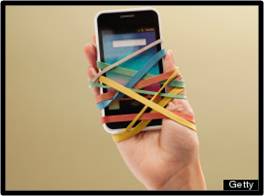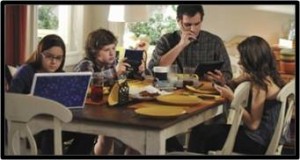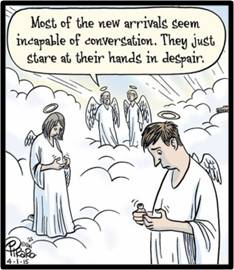Monday Author: Susanne Skinner
 Smart phones represent the double-edged sword of technology. They have a dark side; a gravitational pull that compels us to look, swipe, reply, like, search and comment. It’s becoming impossible to put them down. We are addicted to their siren song of instant information and communication.
Smart phones represent the double-edged sword of technology. They have a dark side; a gravitational pull that compels us to look, swipe, reply, like, search and comment. It’s becoming impossible to put them down. We are addicted to their siren song of instant information and communication.
I cannot write this blog without pointing a finger at myself. There was a time when I had a Blackberry that owned me. I remember the effect it had on me and those I love. This blog sermon is written for the me I used to be and those like me. I stand among you and we know who we are.
The increase in cell phone functionality has created an indispensable piece of technology that has the ability to overtake common sense and good manners.
I’m the first to admit life without a cell phone would be bleak. Our lives are busy. No matter what profession we practice. We are all in the business of information management. We make and receive calls, manage our calendars and have instant access to one another with texting and social media apps. But how much is too much?
Nomophobia
It’s a word. The fear of being without a cell phone is called nomophobia. We have become the people who depend on mobile devices to manage our lives. This has a direct correlation to fomo, the fear of missing out.
Today nearly two-thirds of Americans own a smartphone and use them as the main entry point for online services and information. In fact, many people do not have broadband service or alternate computer options in their home and rely on their smart phone for internet access.
So how can we tell if we’re heading to the dark side? The truth is; we are already there. Nearly half (48%) of smartphone-dependent Americans have to cancel or suspend their cell phone service for a periods of time because the cost of maintaining them is a financial hardship. Many reach the maximum amount of data allowed mid-way through their billing cycle.
Text messaging is the most widely-used smartphone feature, followed by email, social networking and watching/listening to videos, music or podcasts. But young adults (85% of whom are smartphone owners) also use their phones for research and transactional functions.
Nearly three-quarters of smartphone owners use their devices to get directions, find on-line reviews, play games, conduct banking, obtain information about health conditions, research and apply for jobs and check weather and traffic. They are also an escape device, used to avoid boredom and conversation.
The New Normal
The preoccupation with mobile communication includes excessive amounts of money or time spent on the devices as well as socially or physically inappropriate use like driving, mealtime (especially restaurants) and theaters. We are becoming immune to their dangers and the way this behavior affects those around us. Just when you thought it couldn’t get more ridiculous we find petextrians – those who text while walking, unaware of their surroundings.
 Today there are 2.6 billion smartphone subscriptions globally, and it’s not slowing down. By 2020 there will be 6.1 billion, overtaking the number of land-line subscriptions worldwide. By then, over 70% of the world’s population will own and use a smartphone, an indication of just how dependent we will be on these devices. When you take into account Internet-of-Things, M2M services and mobile broadband, there will be 26 billion connected devices in five years’ time.
Today there are 2.6 billion smartphone subscriptions globally, and it’s not slowing down. By 2020 there will be 6.1 billion, overtaking the number of land-line subscriptions worldwide. By then, over 70% of the world’s population will own and use a smartphone, an indication of just how dependent we will be on these devices. When you take into account Internet-of-Things, M2M services and mobile broadband, there will be 26 billion connected devices in five years’ time.
Statistically Here’s How We Look:
- 70% of smartphone users check their phones as soon as they get up
- 56% check them before they go to bed
- 48% check them during the weekend, including evenings
- 51% check them continuously while on vacation
- 44% claim extreme anxiety over a lost, misplaced or forgotten device.
In his book “Removed” photographer Eric Pickersgill created a photographic series that explores the way personal devices reflect our lives. In each photo the devices have been edited out so that people stare at their hands, or the empty space between their hands. This is how we look.
But I’m Not That Person
Wondering if you have a cell phone addiction? Take the “Smartphone Abuse Test,” an online quiz administered by the Center for Technology and Internet Addiction, one of the few organizations focused on the issue. There are 15 questions. If you answer ‘yes’ to five or more of them guess what? You are that person.
 I was that person. I nailed all 15 of those questions. My phone was part of me, always in my hand or next to me. I needed to be reachable at all times. A blinking red light needed to be answered immediately. The truth is; I created that monster. Absolutely nothing was as important as I made it out to be.
I was that person. I nailed all 15 of those questions. My phone was part of me, always in my hand or next to me. I needed to be reachable at all times. A blinking red light needed to be answered immediately. The truth is; I created that monster. Absolutely nothing was as important as I made it out to be.
When I lost my job I got rid of my Blackberry, trading it for a dumb phone that allowed me to say hello and good-bye. Nobody thought I could do it. Even after I got a new job I kept that phone for over a year, afraid I would slide back into the abyss. My decision to step back into the game was work related. I was running a conference with a mobile app, and I was the only one on my team unable to download it.
By then I had gotten better at balancing work and family life. There is no app for that; I worked at it. Not having the phone was the best thing that happened to me. It’s never an all or nothing game—I have to think about the amount of time I want that device to steal from me every single day.
Some days are better than others.
Related Posts:
